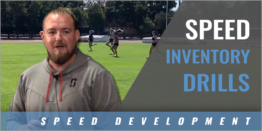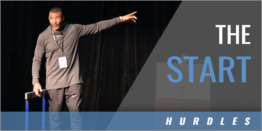|
What's Often Overlooked By: Boo Schexnayder - Director of the Track & Field Academy Originally Published in: Techniques Magazine - USTFCCCA
Record Keeping The quantification of volume can take many forms. Units of measure might be quantified as the number of sets or repetitions performed, meters run, total weight lifted, number of foot contacts, or time spent in work. The quantification of intensity can take many forms as well. In some training modalities, intensities are measure-able. The intensity measurements most used are percentages of maximal effort in weight training exercises, running efforts, or other training activities. At other times, intensity is determined solely by the nature of the exercise chosen, is not readily measurable, and is highly subjective. Still subjective intensity evaluation can be done with some accuracy if the demands of the work are understood. For example, a decision that depth jumps are more intense than in-place jumps may be subjective to some degree, but understanding the increased stresses associated with the depth jumps makes this decision likely to be accurate. Indexing is a systematic approach to the process of planning and recording volumes, or the combined effects of volume and intensity. Intensities may be evaluated objectively or subjectively. An example of a simple indexing system for run training may include multiplying the distance run by the percentage of personal best time (or some factor thereof). This would characterize training with some numerical factor that considers volume and intensity. Various types of multi-jump exercises could be assigned some intensity factor, and the number of contacts performed could be multiplied by this factor to form another such system. Testing Testing should not be done haphazardly, as information gained in this way cannot be used for the purposes intended with any reliability. Tests should be valid, and the testing environment controlled as much as possible. This includes standardizing measurement, number of trials, test sequence, equipment, and warmup practices. Common tests used are listed below. A coach may employ any or all at certain times in the training regimen. 30 Meter Sprint. The 30m sprint test of accelerative power. The athlete runs 30 meters for time from a stationary start. Fly Tests. Fly tests are tests of absolute speed. The athlete runs a particular distance (usually 10 or 30 meters) for time, after having previously accelerated through a designated (usually 20 or 30 meters) acceleration zone. Standing Long Jump. A short bounding exercise, the standing long jump is a test of starting power and reactive strength. The athlete performs a single jump for distance from a standing start. Standing Triple Jump. A short bounding exercise, the standing triple jump is a test of reactive strength, power, and coordination. The athlete, from a double legged standing start, performs three jumps. The test begins with a double leg takeoff, then a right-left or left-right contact pattern prior to landing. Double-Double. A short bounding exercise, the double-double is a complex test of reactive strength, power, and coordination. The athlete, from a double legged standing start, performs five jumps. The test begins with a double leg takeoff, then a right-right left-left or left-left-right-right contact pattern prior to landing. Overhead Back Shot Throw. A multi-throw exercise, the overhead back shot throw is a test of power and coordination. The athlete stands on the shot toe-board facing away from the sector with the shot in both hands. The athlete then squats, lowers the shot below the waist, then throws the shot overhead for distance. Between the Legs Forward Shot Throw. A multi-throw exercise, the between the leg forward shot throw is a test of power and coordination. The athlete stands on the shot toe-board facing the sector with the shot in both hands. The athlete then squats, lowers the shot below the waist, and then throws the shot forward for distance. General Strength Tests. General strength exercises can be used to construct tests of general strength qualities, coordination, and body control. The athlete is asked to perform as many repetitions of a given general strength exercise as possible in a certain period of time. A 30 second situp test is an example. Weight Training Exercise Tests. These are tests of absolute strength and power using weight training exercises as the measurement tool. Safety in testing should always be a priority. Various protocols can be used, and these typically take three forms. Single Repetition Maximums. These tests are designed to determine the maximum amount of weight an athlete can use in a single successful repetition. While these tests have use, they are risky and to be used with care at appropriate times when athletes are prepared for such tests. Multiple Repetition Maximums. These tests are designed to determine the maximum amount of weight an athlete can use when successfully performing a set of some designated number of repetitions. These tests, while demanding, entail less risk than single repetition maximum tests. Projected Maximums. These tests require the athlete to perform as many repetitions as possible with a designated load. This data is then manipulated mathematically to determine a projected single repetition maximum. Projected maximum tests are the safest form of weight testing. It should be understood that in the early stages of training, the single repetition maximum projection does not represent the athlete's abilities at that point, but is a measure of progress and a value to consummate as training progresses.
Periodization of Testing Scheduling of Testing Testing and Adaptation Sequential training may suppress the emergence of improved qualities, and improvements on related tests. For example, a cycle of speed development work may not show improvements in this quality as measured in testing if the next cycle features heavy absolute strength work. This does not mean that the speed cycle has failed; these qualities are likely to emerge later. For this reason, test results are often specific only to one particular training program, or one particular time of year. Testing and Performance Prediction Rest and Restoration Forms of Restoration Active Rest. Active rest is the prescription of some activity of a nature different from traditional training, such as another sport. Restoration Modalities. Restoration modalities are activities that help to eliminate soreness and accelerate recovery from exercise. Restorative modalities include whirlpool (hot or cold), ice baths, sauna, and massage. Restorative Training Units. Restorative training units are traditional training activities that foster recovery from the negative effects of training. They are generally lower intensity activities with a metabolic or mobility component. General strength, medicine ball, hurdle mobility, tempo runs, or bodybuilding lifts can serve this purpose. Periodization of Restoration Alternative medical modalities can be a useful part of restoration. Active release techniques, myofascial release techniques, use of trigger and reflex points, chiropractic medicine, acupuncture, and acupressure may all contribute to the athlete's wellbeing. Lifestyle Issues A complete discussion of nutrition is beyond the scope of this article, but we will examine some general guidelines for thrower's nutritive needs. A proper nutritional plan is essential to the success of the training program. Athletes should eat a variety of nutritious foods and avoid unhealthy choices. The nutritional status of the athlete greatly determines the effectiveness of the training and the ability to handle large training loads. Following are general suggestions for the diets of athletes: Weight Gain/Loss. Weight loss or gain should only be undertaken carefully after much examination and planning, and with extreme patience. The Food Groups. Choosing from and balancing the traditional four food groups (fruits and vegetables, dairy, meats, and grains) is a simple, effective way to plan for general nutrition needs. Avoiding Processed Foods. Highly processed foods (such as sugars, oils, and flours) should be avoided in excess. They are not recognized by the body as foods, and are difficult for the body to process. Diet Construction. The diet should be fairly low in fats and simple carbohydrates. It should be rich in vitamins, minerals, complex carbohydrates, and protein. Insulin Management. Sufficient protein should be present in meals to prevent extreme insulin fluctuations due to the rapid digestion of carbohydrates. Food Preparations. Simply cooked meals or raw foods are nutritionally superior to complex preparations. Meal Distribution. Ideally, several small meals scattered throughout the day is most effective for the athlete. The Importance of Breakfast. Breakfast is extremely important, and should contain some protein-rich food. Variety in the Diet. Eating a variety of foods increases nutritive value of the diet, and enhances immune system function.
Hydration Athletes should drink approximately one gallon of water a day as a minimum. This water is best taken in small servings scattered throughout the day. Increased water intake may be necessary during hot or dry weather, especially when windy. Air travel tends to dehydrate the body quickly, so increasing water intake prior to such trips is advised. Intake of coffee, tea, and carbonated drinks should be limited or eliminated. These act as diuretics and act to dehydrate the body. Supplementation Take extreme care and seek trusted expertise when choosing supplements, and planning the supplementation program. Only choose supplements produced by reputable manufacturers. Consider not only the contents of any supplement, but also how absorbable it is to the body. Even well planned diets may be nutritionally deficient and may need supplementation, because many foods are grown in denatured soils or are nutritionally deficient for other reasons. Supplementation is not a substitute for a good diet. Many supplements require a good diet as a transport system for supplemented nutrients. Many legal supplements contain dangerous substances and should be avoided, and may become even more dangerous when combined with supplements that may be safe otherwise. Extreme care should be taken and labels read closely when purchasing these products. Supplements may contain ingredients that may trigger positive drug tests. One should be familiar with the list of banned substances when using certain types of supplements. As mentioned in the opening paragraph of this article, knowing the technical aspects of coaching the throwing events is a key piece of the puzzle, however it is just that, a piece. Having a working knowledge of the "peripheral" areas will lead to greater success.
Bio: This article was taken from the Track & Field Academy's Throws Specialist Certification Course curriculum. Boo Schexnayder is the Director of the Track & Field Academy and is responsible for the development of the course content. |




 While possessing a thorough understanding of the technical aspects of each of the throwing events is vital to success as a coach, recognizing that there are many, many less talked about and often overlooked components to a training program as well is equally vital. In this article we will examine the "other" components of a well-conceived and well executed training program.
While possessing a thorough understanding of the technical aspects of each of the throwing events is vital to success as a coach, recognizing that there are many, many less talked about and often overlooked components to a training program as well is equally vital. In this article we will examine the "other" components of a well-conceived and well executed training program.




